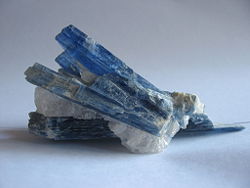Kyanite
| Kyanite | |
|---|---|
 |
|
| General | |
| Category | Mineral |
| Chemical formula | Al2SiO5 (aluminium silicate) |
| Identification | |
| {{{molweight}}} | |
| Color | Blue; also green, white, grey, black |
| Crystal habit | Columnar; fibrous |
| Crystal system | Triclinic |
| Cleavage | [100] Perfect, [010] Imperfect |
| Fracture | Brittle |
| Mohs Scale hardness | 4.5-5 parallel to one axis 6.5-7 perpendicular to that axis |
| Luster | Vitreous; Pearly |
| Refractive index | 1.71 - 1.75 |
| Pleochroism | Trichroic, colorless to pale blue to blue |
| Streak | White |
| Specific gravity | 3.56 - 3.67 |
| {{{density}}} | |
| Solubility | None |
| Diaphaneity | Transparent to translucent |
Kyanite, whose name derives from the Greek word kyanos, meaning blue, is a typically blue silicate mineral, commonly found in aluminium-rich metamorphic pegmatites and/or sedimentary rock. Kyanite is a diagnostic mineral of the Blueschist Facies of metamorphic rocks.
Kyanite is a member of the aluminosilicate series, which includes the polymorph andalusite and the polymorph sillimanite. Kyanite is strongly anisotropic, in that its hardness varies depending on its crystallographic direction. While this is a feature of almost all minerals, in kyanite this anisotropism can be considered an identifying characteristic.
Uses of kyanite
Kyanite is used primarily in refractory and ceramic products, including porcelain plumbing fixtures and dinnerware. It is also used in electrical insulators and abrasives. An interesting property of kyanite is that it undergoes an irreversible expansion when fired at high temperature.[citation needed] Kyanite has also been used as a gemstone, though this use is limited by its anisotropism and perfect cleavage. Finally, as with most minerals, kyanite is a collector's mineral.
Associated minerals
Kyanite is usually found in association with its polymorphs, as well as other silicate minerals. These include:
- andalusite, Al2SiO5
- sillimanite, Al2SiO5
- quartz, SiO2
- staurolite, Fe2Al9Si4O22(OH)2
- micas, AB2-3(X, Si)4O10(O,F,OH)2
- garnets, A3B2(SiO4)3
Alternative names
Kyanite has several alternative names, including disthene, munkrudite and cyanite. White-grey kyanite is also called rhaeticite.
Notes for identification
Kyanite's elongated, columnar crystals are usually a good first indication of the mineral, as well as its color (when the specimen is blue). Associated minerals are useful as well, especially the presence of the polymorphs or staurolite, which occur frequently with kyanite. However, the most useful characteristic in identifying kyanite is its anisotropism. If one suspects a specimen to be kyanite, verifying that it has two distinctly different hardnesses on perpendicular axes is a key to identification.
ReferencesISBN links support NWE through referral fees
de:Kyanit es:Cianita eo:Kianito hr:Kijanit it:Cianite he:קיאניט hu:Kianit nl:Kyaniet ja:藍晶石 pl:Dysten pt:Cianite ru:Кианит sk:Kyanit fi:Kyaniitti sv:Kyanit
